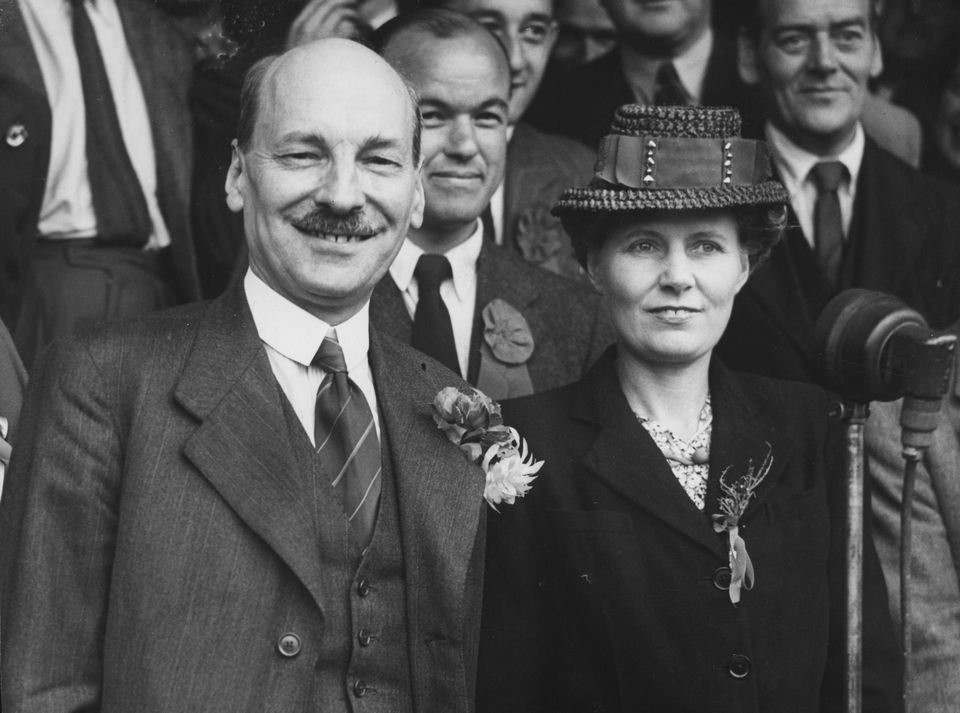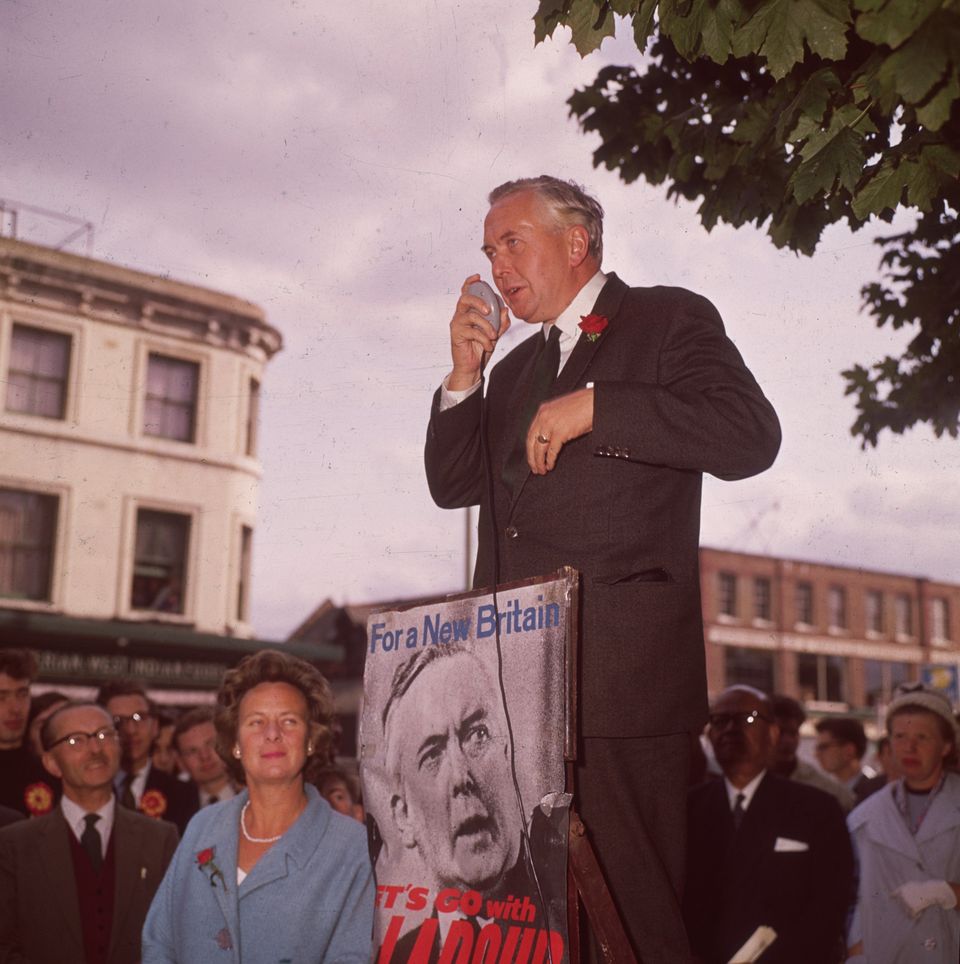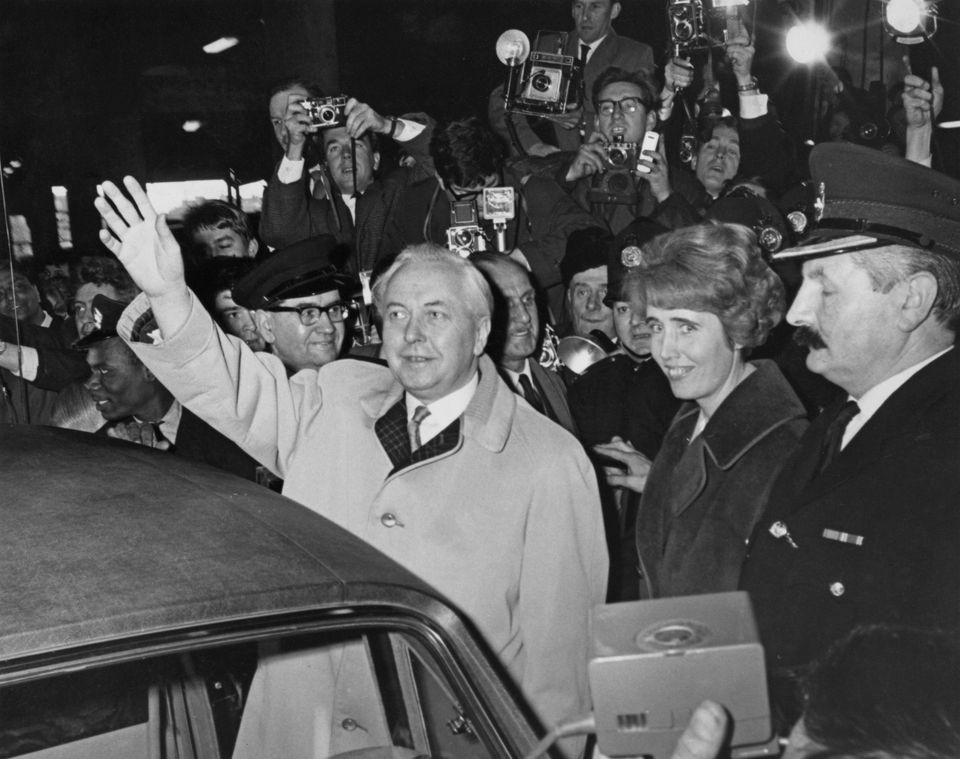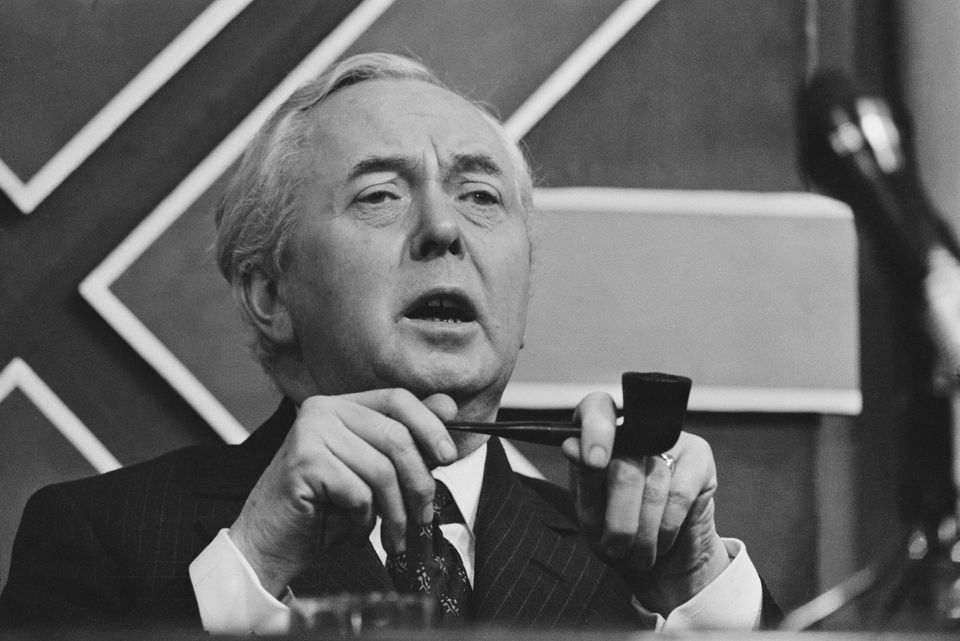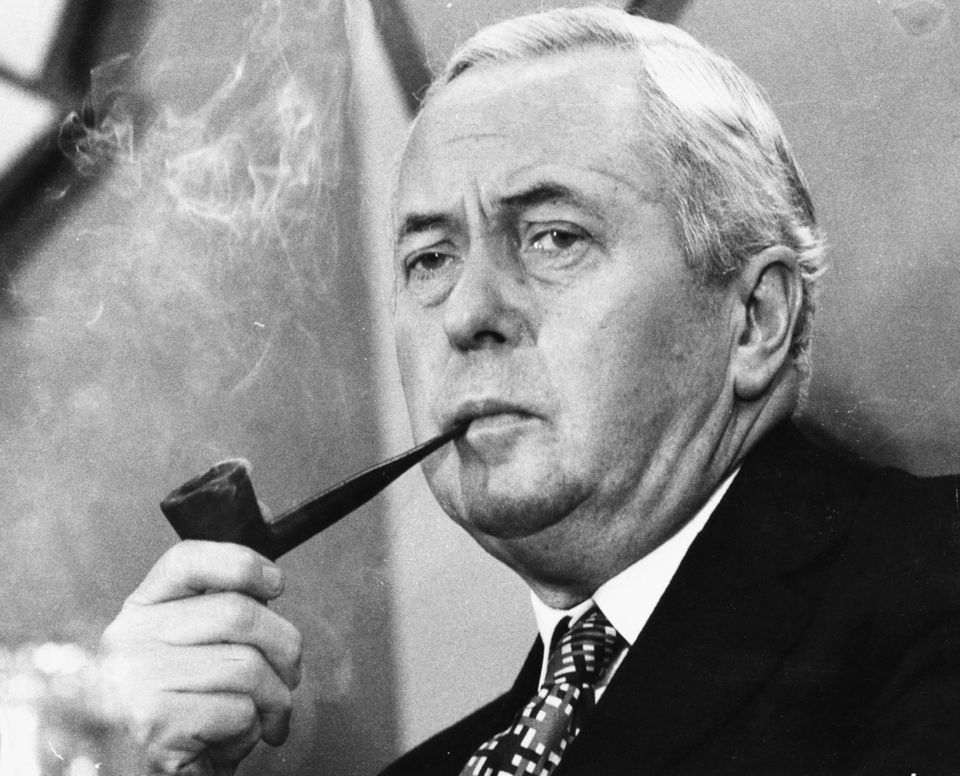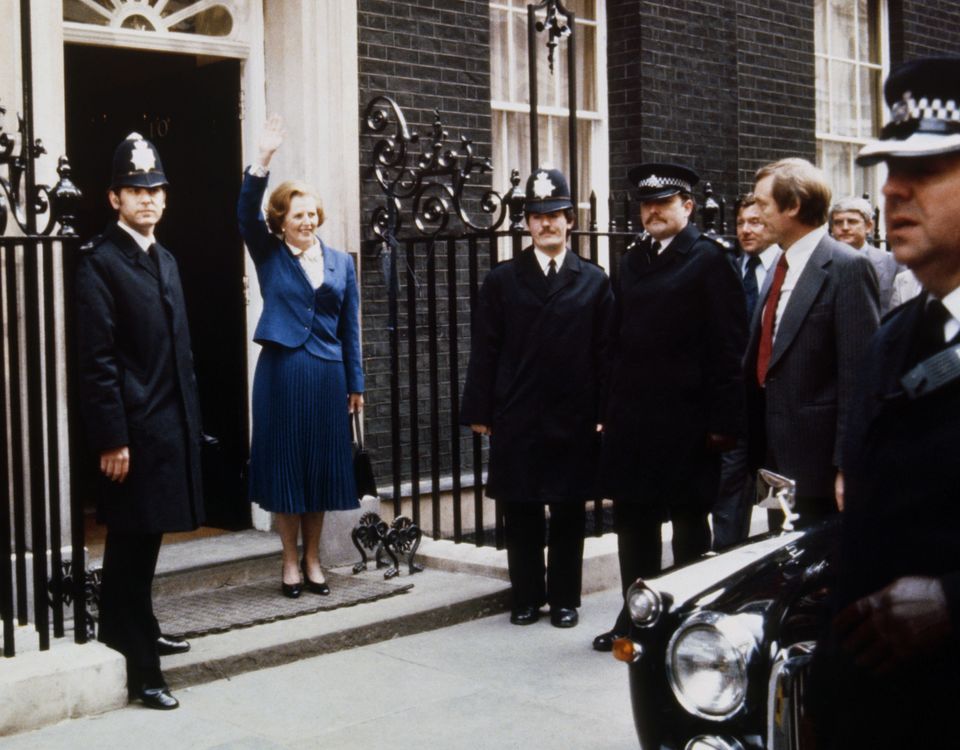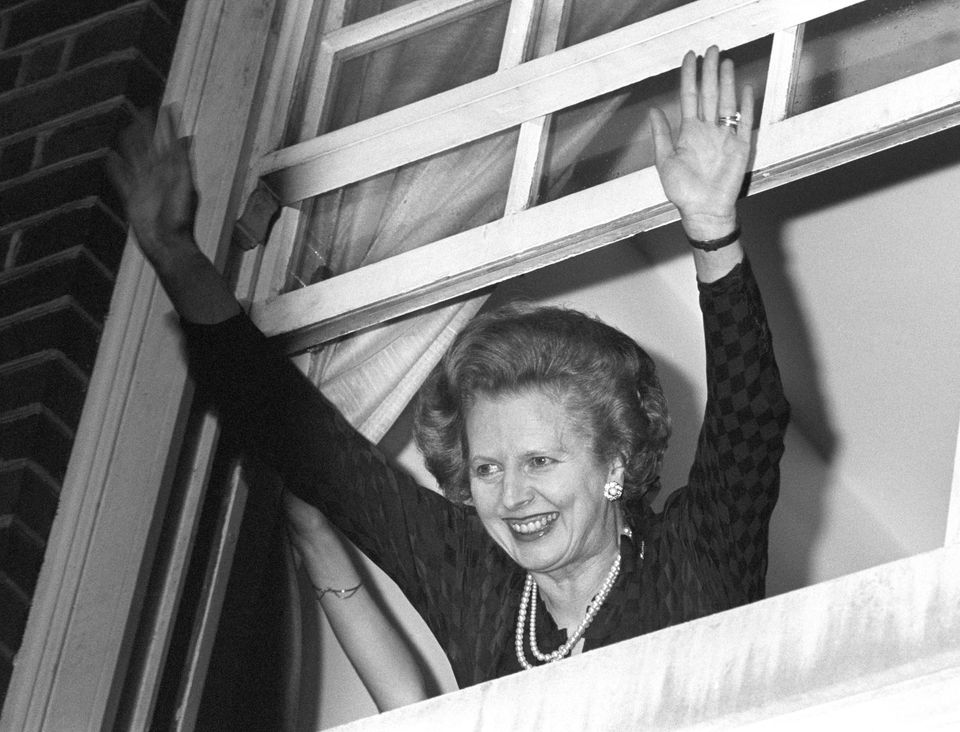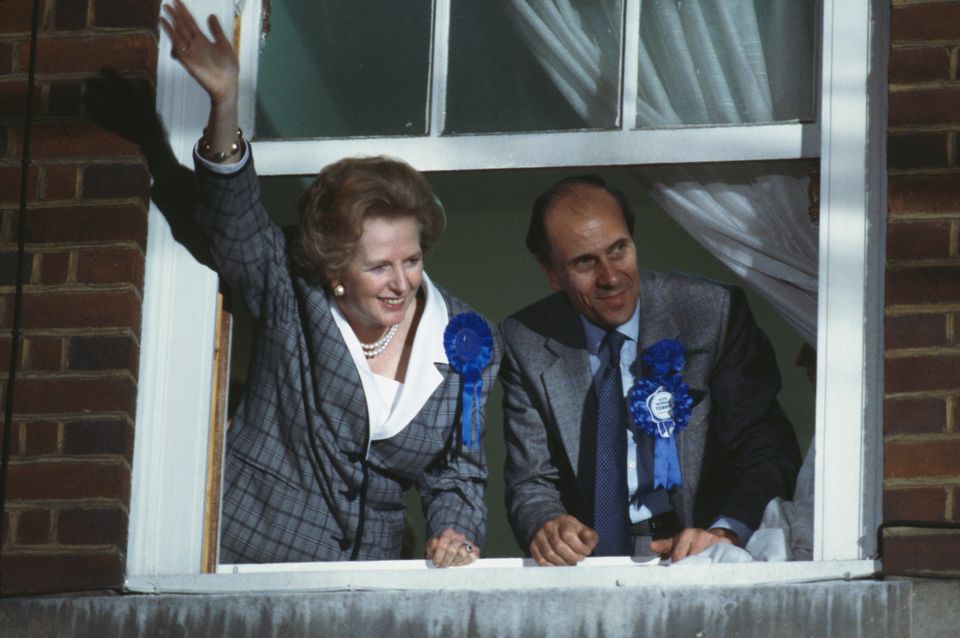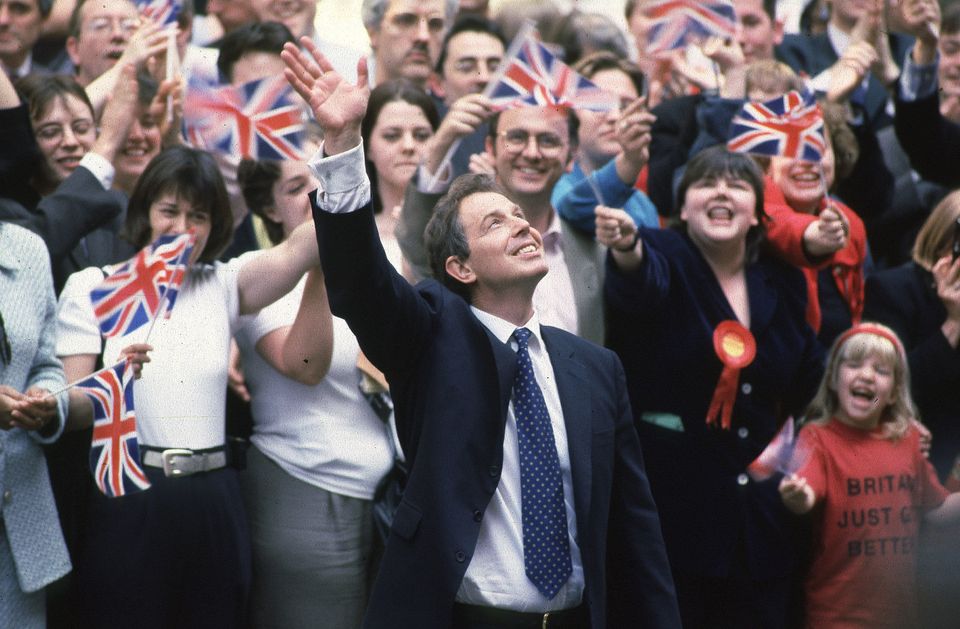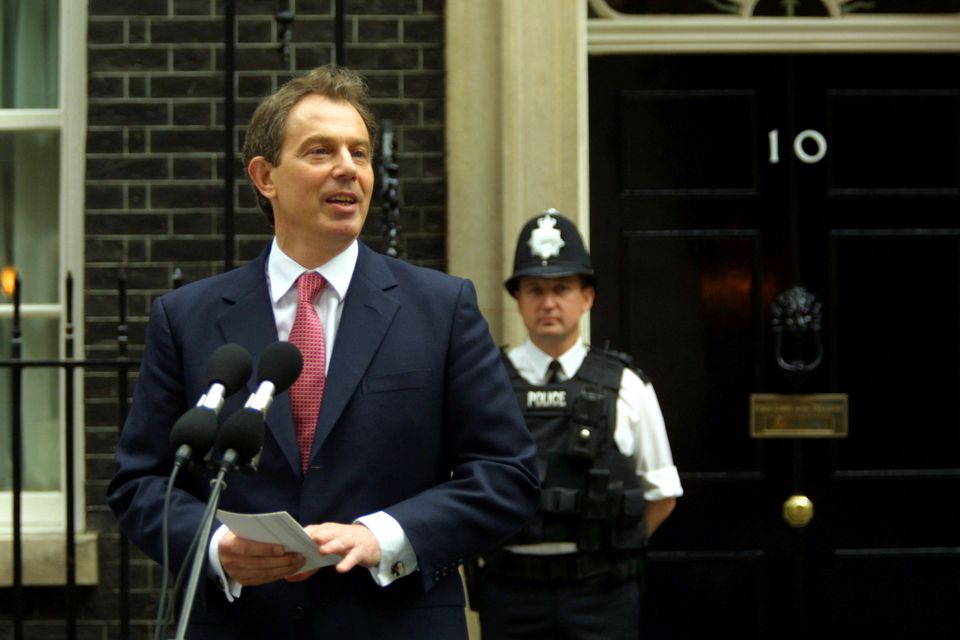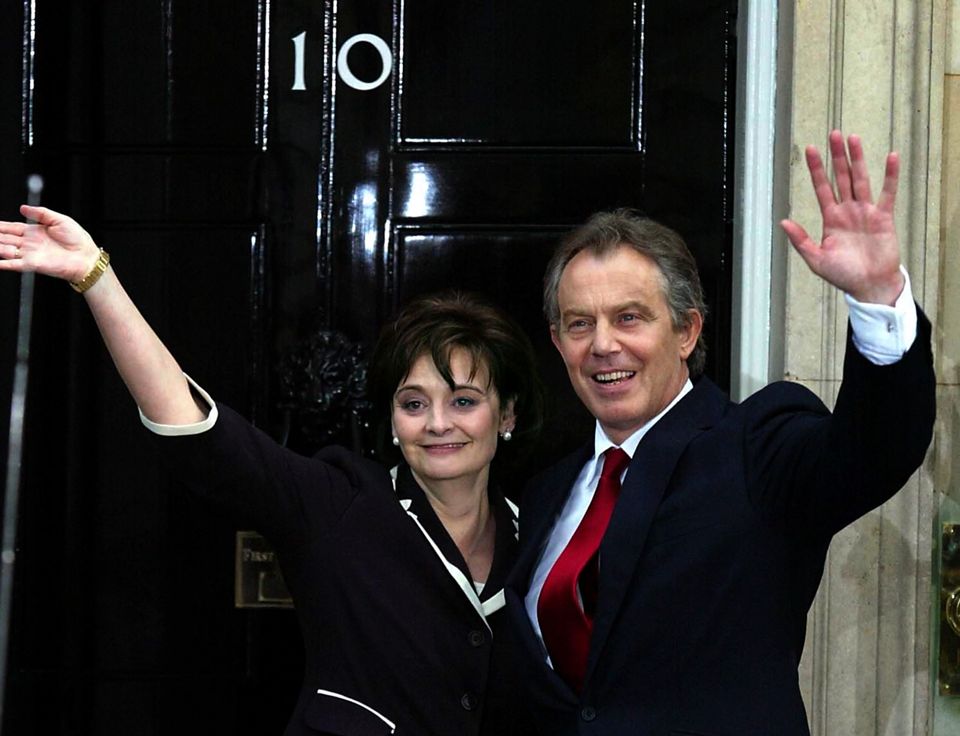Labour’s vote share is more likely to be overestimated in the run up to a General Election than the Tories’, HuffPost UK analysis has found.
Scrutinising data going back to 1943, HuffPost UK discovered that the average of opinion polls in the week before an election overestimated Labour support in 11 of 19 General Elections.
In a mirror image, the Conservative vote share was underestimated on 11 occasions.
Labour will need to overturn that phenomenon to win this year’s election, as an average of the polls in the final week of campaigning puts the Tories on 42.8% and Labour on 36.8%.
Even during the great Labour landslides of 1966, 1997 and 2001, the polls were showing more support for the party at the ballot box than it eventually received.
The most drastic example of this was in 1970, when pollsters predicted the Labour government would get 48.4% of the votes- it instead picked up just 43.8% and lost the election.
Of the last ten general elections, the Labour vote has been overestimated in seven, while Tory support has been under-detected in eight.
Opinion Polls vs Actual Results - 1945 to 2015
5 July 1945 - Labour wins by 145 seats
Central Press via Getty Images
Polling was limited during the Second World War, so there is limited data to analyse. Yet of the nine Gallup/News Chronicle polls taken from June 1943 to the 1945 election, Labour was ahead in every one – with Clement Attlee enjoying a 20-point lead in February 1945.
Average of two polls carried out in June 1945
Conservative: 39%
Labour: 46%
Liberals: 12.75%
RESULT
Conservative: 39.3%
Labour: 48.8%
Libs: 9.2%
Verdict: Despite only nine being taken, the polls were pretty accurate. The Labour vote was slightly underestimated, but the Tory support was almost spot on.
23 February 1950 - Labour win with a majority of 5
Derek Berwin via Getty Images
Polling became more frequent after 1945, but still only took place every 2-3 months. According to the data, the Conservatives were ahead for the majority of the parliament, although Labour pulled it back slightly in the run up to polling day.
Average of Final Month’s polls
Conservative: 44.3%
Labour: 44.6%
Liberals: 10%
RESULT
Con: 43%
Lab: 46.8%
Lib: 9.3%
Verdict: The polls underestimated the Labour vote, and over-stated Tory support.
25 October 1951 - Conservative win with a 17 majority
Keystone via Getty Images
There were eight polls carried out after Attlee dissolved Parliament at the beginning of September. The first one – conducted on September 26 by Gallup for the News Chronicle, gave the Tories an 11 point lead over Labour (52 v 41, with the Libs on 6.5). The remaining seven polls carried out in September had the Tories go from 50.5% to 50% , until the final survey conducted three days before the vote put them on 49.5%. Labour saw its support grow from 41 to 47%, while the Liberals shrunk to 3.5%.
Average of final week’s polls:
Conservative: 49.9%
Labour: 45.6%
Libs: 4.1%
Result:
Conservatives: 47.8%
Labour: 49.4%
Liberals: 2.6%
Verdict: The polls got the right conclusion but the wrong result. Labour won the national vote, but the Tories picked up more seats, meaning they formed the Government.
26 May 1955 - Conservative win with majority of 60
Central Press via Getty Images
The Conservatives were ahead in all five Gallup/News Chronicle polls carried out in May 1955 – a lead that grew as the campaign went on. The Tories started the month of the election on 48.5%, 1 point ahead of Labour, but by polling day the lead had extended to 3.5 percentage points.The final Gallup/News Chronicle poll had the Conservatives on 51%, Labour on 47.5% and the Liberals on a miserly 1.5%. The actual result – in terms of vote share – saw the Tories beat Labour by 1.9 percentage points.
Average of final week's polls:
Conservative: 51%
Labour: 47.3%
Liberals: 1.8%
Result:
Conservative: 49.3%
Labour: 47.4%
Liberals: 2.8%
Verdict: Virtually spot on with the Labour vote, but slightly overestimated Tory support.
October 8 1959 - Conservative win with a 100 seat majority
PA Archive/PA Images
Despite Labour being ahead in the polls for much of the Parliament – including a 13 point lead in May 1958 - they entered the election campaign trailing the Tories. Of the nine opinion polls conducted in October 1955, Harold Macmillan’s Conservatives were behind in just two. Labour went into the final week of the campaign on 46% in a Forecasting/Telegraph poll, with the Tories on 49%.
Average of final week's polls:
Conservative: 48.2%
Labour: 45.9%
Libs: 5.6%
Result:
Conservative: 48.8%
Labour: 44.6%
Libs: 6%
Verdict: This time it was the Labour support that was overestimated, while the Tory prediction was quite close.
15 October 1964 - Labour win with majority of four seats
William Vanderson via Getty Images
As with the previous Parliament, Labour enjoyed a huge poll lead over the Tories in the years before the election. One survey in June 1963 gave Harold Wilson’s party a 20.5 point lead over the Tories. Alec Douglas-Home slowly ate into that advantage when he took over as Prime Minister in October 1963, and within 10 months the Tories were actually ahead by in a smattering of polls. In the run up to election day, the polls were erratic, with the Daily Express putting the Tories 3.6 percentage points ahead on October 7, while Gallup gave Labour an eight point lead four days later.
Average of final week's polls:
Conservative: 44.2%
Labour: 46.6%
Libs: 8.8%
Result:
Conservatives: 42.9%
Labour: 44.8%
Liberals: 11.4%
Verdict: Here it’s the Liberals who were underestimated, with both Labour and the Tories getting a less share of the vote than predicted.
31 March 1966 - Labour win with a majority of 98 seats
Central Press via Getty Images
Of the 66 opinion polls taken between the 1964 and 1966 elections, Labour was ahead in 60. After Parliament was dissolved on March 10, 19 polls were taken – all giving Labour a healthy lead. In the final week, Labour had leads of 14.5, 12.5 and 16.7 over its Tory rivals, who were unable to get above 42% support.
Average of final week's polls:
Conservatives: 40.3%
Labour: 51.7%
Libs: 7.6%
Result:
Conservatives: 41.4%
Labour: 48.8%
Liberals: 8.6%
Verdict: The Conservatives did slightly better than expected, while Labour did slightly worse. Again, the Liberal vote was underestimated.
18 June 1970 - Conservative win with a majority of 30
PA Archive/PA Images
Labour’s extended honeymoon in the polls lasted until the Autumn of 1967, when the Tories began getting big leads. In May 1968 Ted Heath’s Conservative Party was 28 points ahead, and continued to lead Labour until April 1970. After this, Wilson began to pull away from Heath, and a NOP/Daily Mail poll published on June 12 – just six days before polling day – gave Labour a 12.4 point lead. Of the final six polls conducted, the Tories had the lead in just one – and that was only by a point.
Average of final week's polls:
Conservatives: 46.2%
Labour: 48.4%
Libs: 6.9%
Result:
Conservatives: 46.2%
Labour: 43.8%
Liberals: 7.6%
Verdict: The first big mistake from the polling industry. A Labour victory was predicted, but their support was overestimated by 4.6%.
February 28 1974 - Labour won most seats but it was a hung parliament
Reg Lancaster via Getty Images
Ted Heath called an election 15 months before he had to, framing the campaign as a matter of leadership. Throughout his premiership, Heath had been behind in the polls, but in the run up to polling day the Conservative performed a recovery. Every poll conducted after Heath called the election on February 7 put the Tories ahead – apart from one which gave Labour a 2.5 point lead. Just four days before election day the Tories were seven points ahead, and although that lead shrunk to between five and two points over the remaining days of the campaign, they were still ahead.
Average of final week's polls:
Conservative: 38.8%
Labour: 35.5%
Liberals: 22.9%
Result:
Conservatives: 38.6%
Labour: 38%
Liberals: 19.8%
Verdict: Another mistake. After overestimating the Labour vote in 1970, it was underestimated this time. The gains seem to come from the Liberals, who polled lower than expected.
October 10 1974 - Labour win with a majority of 3 seats
Monti Spry via Getty Images
Harold Wilson called a snap election to try and turn his minority government into a majority one. Looking at the polls between February and September 18 – when Wilson called the election – it is easy to understand why the Labour leader was keen to go the country. Labour had been ahead in 21 of the 24 polls, and every survey carried out throughout the campaign put Wilson ahead. The Tories were trailing around 10 points heading into polling day, but the result was much tighter than predicted.
Average of final week's polls:
Conservative: 34.1%
Labour: 42.9%
Liberals: 19.2%
Result:
Conservatives: 36.6%
Labour: 40.2%
Liberals 18.8%
Verdict: The polls got the right result, but their final predictions were not completely accurate. The Tories did better than suggested before the vote, while Labour and the Liberals did worse.
May 3 1979 - Conservatives win with a majority of 43
PA Archive/PA Images
The polls swung back and forth during this Parliament, with a Tory lead of 25 points in November 1976 turning into a Labour lead of 8 points by December 1977. As the clock ran down to the 1979 election, Margaret Thatcher’s Conservatives established a consistent advantage. A Research Survey/Observer poll published on April 8 gave the Tories a 21 point advantage, but that lead shrank as polling day got closer. An NOP/Daily Mail poll on May 1 gave Labour a 0.7 point lead, but the final five surveys were all positive for Thatcher – and she went into the vote ahead by 7 points (NOP/Daily Mail); 2 points (Gallup/Daily Telegraph); and eight points (MORI/Evening Standard).
Average of final week's polls:
Conservative: 45.2%
Labour: 39.4%
Liberals: 12.7%
Result:
Conservative: 44.9%
Labour: 37.7%
Libs: 14.1%
Verdict: The growing support for the Tories was picked up by the pollsters, who only very slightly over-estimated their popularity. Labour’s vote was again inflated, while the Liberals did better than expected.
June 9 1983 - Conservative win with a majority of 144
PA Archive/PA Images
Despite Margaret Thatcher’s success in the 1979 election, the Tories were consistently behind in the opinion polls until April 1982 – but not always to Labour. The Roy Jenkins-led Social Democrats Party – formed in 1981 – seemed popular with the public, and a poll in December 1981 put them on 50.5% - with the Tories on 23% and Labour on 23.5%. But after a MORI poll gave the Conservatives a 6% lead in April 1982 (Cons 36; Lab 30; SDP 31), Thatcher’s party never went behind again. Of the 15 polls carried out from June 1 to election day, the Tory average lead was 19 points.
Average of final week's polls:
Conservatives: 45.9%
Labour: 26.3%
SDP/Liberals: 25.8%
Result:
Conservatives: 43.5%
Labour: 28.3%
SDP/Liberals: 26%
Verdict: This disastrous election for Labour would have been worse if the polls were correct. Support for the SDP/Liberal Alliance was accurately reflected in the polls.
11 June 1987 - Conservative win with a majority of 102
Georges DeKeerle via Getty Images
The Tories popularity held up in this Parliament until Spring 1985, when Labour began edging ahead. By August of that year, a Gallup/Daily Telegraph poll even put Neil Kinnock’s party 16 points ahead of the Conservatives. Labour held its lead over the Tories through much of 1986, but by December Margaret Thatcher was again in front. Apart from three polls at the beginning of the year, 1987 saw the Tories in the lead in every survey. Of the 17 polls in June, the Conservative lead averaged an 8.7percentage point advantage over Labour.
Average of final week's polls:
Conservatives: 42.9%
Labour: 33.8%
SDP/Liberals: 21.6%
Result:
Conservatives: 43.3%
Labour: 31.5%
SDP/Liberals: 23.1%
Verdict: Hopes of a Labour comeback were inflated by the polls in the run up to the election, and it seems the SDP/Liberal alliance was more resilient with voters than expected.
April 9 1992 - Conservative win with majority of 21
PA Archive/PA Images
Up until May 1989, the Conservatives dominated the polls, and double digit leads over Labour were not uncommon. Yet after a MORI poll gave Labour a 2 point lead on May 28, Kinnock’s party began to consistently find itself ahead of the Government. April and May of 1990 saw leads of 28, 27 and 24 for Labour. After 17 months of trailing in the polls, the Conservatives finally snuck ahead with 2 point lead in November 1990 after Thatcher was ousted from Downing Street by her own party. The bounce was short-lived and six months later Labour was again consistently ahead. As the 1992 election grow closer, the Tories and Labour swapped poll leads repeatedly, but in the 16 surveys carried out in the 9 days before polling day, Labour was ahead in 12.
Average of final week's polls:
Conservatives: 37.7%
Labour: 39%
Lib Dems: 19.5
Result:
Conservative: 42.8%
Labour: 35.2%
Lib Dems: 18.3%
Verdict: Another major error by the polling industry. The Tory vote was 5 points higher than suggested, and Labour’s was nearly 4 points down.
May 1 1997 - Labour victory with 179 seat majority
Jeff Overs via Getty Images
After winning more votes than any Prime Minister in history, John Major only managed to stay ahead in the polls for three months. Even before Black Wednesday on 16 September 1992, Labour were marginally in front but the economic crash pushed them way ahead. From Black Wednesday to the date of the 1997 election, Labour were never behind in an opinion poll. A Gallup/Daily Telegraph survey in January 1996 even gave Tony Blair’s party a 39.5 point lead over the Tories.
Average of final week's polls:
Conservatives: 30.4%
Labour: 48.3%
Lib Dems: 14.9%
Result:
Conservative: 31.0%
Labour: 44.0%
Lib Dems: 17%
Verdict: Even in Tony Blair’s landslide of 1997 the polls overestimated Labour’s support. The Tory vote share prediction was close to the result, while the Lib Dems did better than expected.
June 7 2001 - Labour win with a majority of 167
Sion Touhig via Getty Images
Tony Blair’s popularity endured throughout his first term as Prime Minister, and it wasn’t until January 1998 his poll lead slipped below 20 points. The only time the Tories were ahead was in September 2000 in the wake of fuel protests that led to petrol stations running dry. Labour were soon back in front, and had double digit leads heading into polling day.
Average of final week's polls:
Conservatives: 31.4%
Labour: 45.6%
Lib Dems: 15.3%
Result
Conservative: 32.7%
Labour: 42%
Lib Dems: 18.8%
Verdict: Virtually a repeat of 1997, with Labour’s support inflated, and the Tories and Lib Dems underestimated.
May 5 2005 - Labour win with a majority of 66
PA Archive/PA Images
Labour continued it’s dominance in the polls, and it wasn’t until June 2003 that the Tories got their noses in front with a 2 point lead. The two parties swapped the lead over the next year, but once Labour got ahead in September 2004 it stayed in front in virtually every survey until polling day.
Average of final week's polls:
Conservative: 31.7%
Labour: 37.8%
Lib Dem: 22.6%
Result
Conservative: 33.2%
Labour: 36.2%
Lib Dem: 22.6%
Verdict: Labour’s vote share was lower than predicted, and again, the Tories were higher. The Lib Dem monitoring was extremely accurate.
May 6 2010 - Conservative largest party in hung parliament
Bloomberg via Getty Images
Labour’s poll lead evaporated by April 2006, with the Tories as much as 10 points ahead in the following 15 months. Labour received a boost when Gordon Brown took over as Prime Minister, but after failing to call a snap election in October 2007 the Tories went ahead and stayed in front until polling day. Some polls leading up to the election put the Lib Dems on an equal voter share with Labour, leading the country to prepare for a hung parliament.
Average of final week's polls:
Conservative: 35%
Labour: 27.3%
Lib Dems: 27.7%
Result:
Conservatives: 36.9%
Labour: 29.7%
Lib Dems: 23.6%
Verdict: Cleggmania seemed to infect the pollsters in 2010, with the Lib Dems getting a four point boost compared to the actual result. Those voters seem to have gone to Labour and the Tories, who both achieved better results than predicted.
May 7 2015 - Conservative win with majority of 12
PA Archive/PA Images
The Tories kept their lead over Labour until September 2010, and after the two parties jostled for first place for a few months, Ed Miliband leapt ahead from December 2010. Given the final result, its remarkable just how consistently Labour was ahead of the Tories throughout the majority of the Parliament, and it wasn’t until October 2014 that David Cameron’s party started drawing level with Team Miliband. In the election run-in, the parties swapped the lead on numerous occasions, and in the final week were level in eight polls.
Average of final week’s polls:
Conservative: 33.7%
Labour: 33.5%
Lib Dem: 9.2%
Result:
Conservative: 37.7%
Labour: 31.2%
Lib Dem: 8.1%
Verdict: One of polling industries greatest errors in UK election history. The Tories picked up 4 points more than predicted, giving them an unexpected majority.
